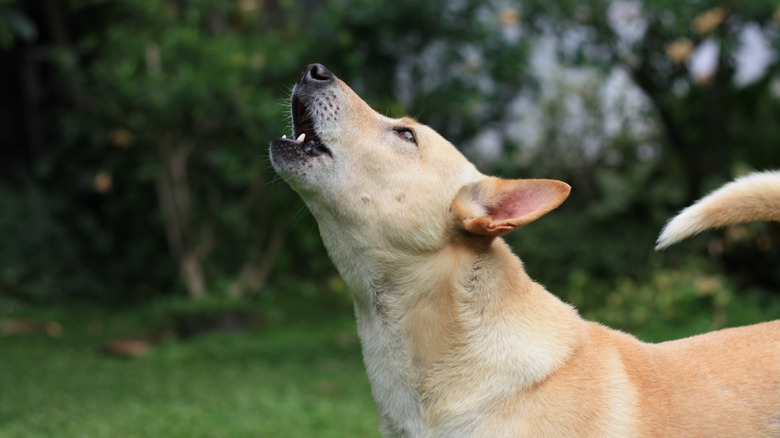Those Different Sounds Your Dog Makes Have More Meaning Than You Think
Dogs communicate their wants and needs to humans in a variety of ways. They use body language and sounds to tell you things, but it is best to learn about the different sounds they make for you to know what they are trying to say. Different dog breeds can have unique vocalizations, but there are several that all dogs have in common, as noted by the American Kennel Club. Some of these include growling, sighing, barking, and whining.
It's important to know the meaning behind these sounds so you can better take care of your canine companion. The sounds, combined with your dog's body language, allow you to determine what your dog is trying to convey. Learning the meaning behind the sounds and actions can improve your relationship with your pooch and make you a better dog parent. Here are some of the common sounds you hear from your dog and what they mean.
Barking
A bark is the most common sound a dog makes, which makes it quite difficult to decipher its meaning. It's best to assess the situation to understand what your dog is trying to say. It typically means the dog is trying to get your attention. For instance, your pooch may bark when someone is at the door to alert you of potential danger (via Reader's Digest). Your dog may also bark directly at you if it wants to play. Barking can mean fear, happiness, or excitement.
You can better understand a dog's bark if you listen carefully to the pitch, frequency, and duration, as reported by Hepper. High-pitched yapping accompanied by tail-wagging often means happiness, while more aggressive barking can mean danger. The more frequent the barking, the more urgent the matter is. As you spend more time with your dog, will be easier to determine the meaning behind the different barks.
Howling
When a dog howls, it's typically a way to communicate with other dogs. It's quite common for a dog to respond after hearing a dog howling from far away. Per Dogster, howling is in a dog's genes and it is a behavior passed down from their wolf descendants. When dogs howl together, it gives them a sense of belonging to a pack. Pet dogs sometimes howl when their owners are away from them for a long time, and it's a way for them to call their owners home. For dogs who are often left alone with no companion, howling can be a sign of separation anxiety.
Howling can also simply be a response to environmental factors, such as the siren of a police car or an ambulance. It is used to attract attention as well. Howling isn't typical for all dog breeds, however. Some of the dogs that are known to howl the most include Bloodhounds, Huskies, and Malamutes.
Growling
Many assume that growling is a form of aggression, but that is not always the case. Most often, a dog growls to a person or another dog as a warning that a bite may soon follow. Dogs growl at unfamiliar dogs to show dominance, too. Growling can also mean fear, which typically happens when the dog feels threatened or doesn't want to be touched, according to Reader's Digest. If you observe your dog growling, it is best to put distance between your pooch and the object, animal, or other person causing stress to avoid escalation.
On the other hand, dogs can also elicit a playful growling sound when playing. This is different from an aggressive growl, as it is more subdued, per Dog Time. This is common when you play tug-of-war or wrestle with your dog. Playful growls are not alarming, and it's an indication that your pup is enjoying the experience.
Whimpering
When a dog whimpers or whines, it usually means that it wants something such as food, playtime, a bathroom break, or simply your attention. The whining will stop once they get what they want. For some dogs, whimpering can also be a sign of distress or anxiety, per the American Kennel Club. For instance, a dog may whimper if it knows that its owner is about to leave for the day.
Whimpering can also mean that your dog may be suffering from an ailment. If the whimpers are accompanied by appetite loss, lack of energy, or unusual behavior outside the norm, the dog may be experiencing pain or discomfort. It's important to seek medical help, as your dog may be suffering from a serious condition that needs immediate medical attention. It's important to look at the dog's other actions in order to have a better understanding of what they truly need.
Snoring
Just like humans, dogs sometimes snore when they are in a deep state of sleep. This is quite normal for canines, especially for dog breeds that have short snouts. Snoring can be the result of the dog's sleeping position or dreams. There are cases when dogs bark or whimper while they are asleep, as they may be dreaming. According to Southern Living, a dog's brain activity while asleep is similar to a human's. They also go through sleep cycles and make noises just like we do.
However, there are also instances when snoring is a sign of an underlying medical condition, such as hypothyroidism or sleep apnea, per Insider. It's best to observe how your dog snores to see if medical help is required. Dogs who suffer from the said ailments typically snore more loudly and more often. If your dog doesn't typically snore and suddenly begins snoring, it's a sign that it's time to visit the vet for a check-up.





